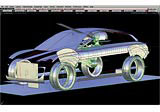The right direction
Peter Horbury brings his driving ambition to Ford in his new role as design director. Nargess Shahmanesh finds out how he will implement his visions

Peter Horbury has definite views when it comes to design, which is probably one of the reasons why Ford has made him executive director of design for its Premier Automotive Group.
In the job for a month now, Horbury is perhaps best known as the man responsible for reviving the Volvo brand, and his design philosophy probably owes much to his 11 years spent in Sweden leading the design team. Now all eyes are on him to see how the Scandinavian influence that has shaped his design language will be put to use in London.
Ford created PAG in 1999 to include high-end car brands Aston Martin, Jaguar, Land Rover, Lincoln and Volvo under one umbrella. The idea was to expand across the market rather than concentrate on only its volume brand. ‘The brands that were chosen had smaller volumes, but had room to expand. No brand was stepping on another’s feet. It’s a nice mixture of clearly defined identities,’ Horbury says.
Horbury is in charge of the overall design strategy of PAG. He is based at Ford’s Ingeni design centre in London’s Soho, although he doesn’t think he will be directly involved with the design studio. ‘We are in the same building, so I may be of some use to them,’ he says. Each PAG brand will retain its own design chief and team, and his task is to maintain and promote those differences. ‘From my perspective it puts design high on the agenda,’ he adds.
Horbury mentions differences between design dictator and design director. It is quite obvious what a dictator does, he says. He has to get involved in every little project, make changes and keep on checking up on things. ‘[Working] this way, you lose the participation of others,’ he says.
A design director, on the other hand, is more like a good film director, he suggests. ‘He or she doesn’t always write the script or act, nor does he hold a camera or edit the film. But at the end of the day, whose creation is it? The director has had the vision, and achieved that through the efforts of other people.’ But what if a PAG designer disagrees with his vision? ‘Then we have to discuss it until they persuade me that I am wrong,’ he says.
Horbury’s plans for PAG are still under wraps, but he does admit that, together with Jaguar’s chief designer Ian Callum, he is working on the design direction of the brand. Jaguar is on the right track, he explains, but as with Volvo, once people get used to change, then you can begin to accelerate.
Ford is strongly focused on design, he insists, as the design team is where the inventiveness comes from, not surprisingly. ‘When we have our meetings with J Mays [Ford’s vice-president of design and the man Horbury reports to] and all the other designers, we get very excited about each others work,’ he says.
Horbury recalls a time at college when projects often tended to be inventive rather than design-led. He says this is exactly what he’s trying to do at Ingeni. He says, ‘We want to create designer-inventors, whereby our designers start to think what would the customer want in ten years time.’
Ford pays particular attention to its customers and has a team dedicated to making designers aware of who they are designing for. ‘We learn so much from this market research. We go off on design trips to different markets, meet the customers in dealerships and pick up interesting points,’ he adds.
Horbury is a strong advocate of looking at culture when it comes to car design. He believes the cultural aspect of different brands enhances their ‘uniqueness’. ‘There is something exotic about buying from abroad,’ he says. He adds that you cannot help but be influenced by other design, and in Sweden the influence tends to come from furniture design.
‘Luxury in Sweden means unnecessary excess, which is frowned upon. So you achieve this in the quality of material used and simplicity of design,’ he says.
This is quite different from, say, Jaguar, which needs to reflect British luxury. ‘What we look for in Jaguar is modern British: its modern architecture, fashion and industrial design, which are respected around the world. What we need to do is to pick out what is technically British in this field and this becomes Jaguar’s next design philosophy.’ Unfortunately, he adds, British cars often represent the culture of the past.
Horbury doesn’t believe in fashion-led decoration that can date quickly. ‘Swedish design is pure and simple, has no decoration and seldom dates. The society does not encourage any form of ostentation.’ So will he be bringing this design philosophy to the PAG brands? In terms of philosophy, yes, but he also plans to encourage cultural differences. ‘The brand must get to the point where its identity is so established that you will know it is a certain brand, but not know why.’
Peter Horbury’s CV
1950: Born in Alnwick, Northumberland
1968: Studied industrial design at Newcastle-upon-Tyne College of Art
1972: Royal College of Art masters in automotive design, sponsored by Chrysler UK
1974: Joins Chrysler design team
1979: Joins Volvo as a design consultant in Gothenburg, Sweden and later becomes design consultant at Volvo Car BV in The Netherlands
1986: Helps establish a design department for UK engineering company, MGA Developments
1991: Design director at Volvo
2002: Executive director of design at Ford Premier Automotive Group
-
Post a comment



